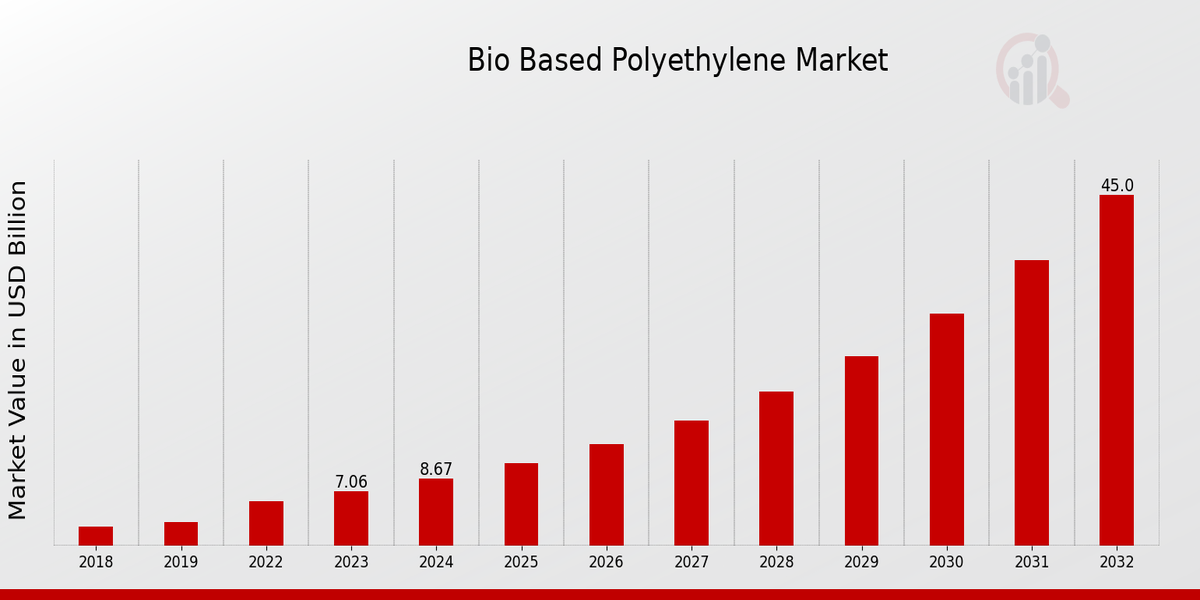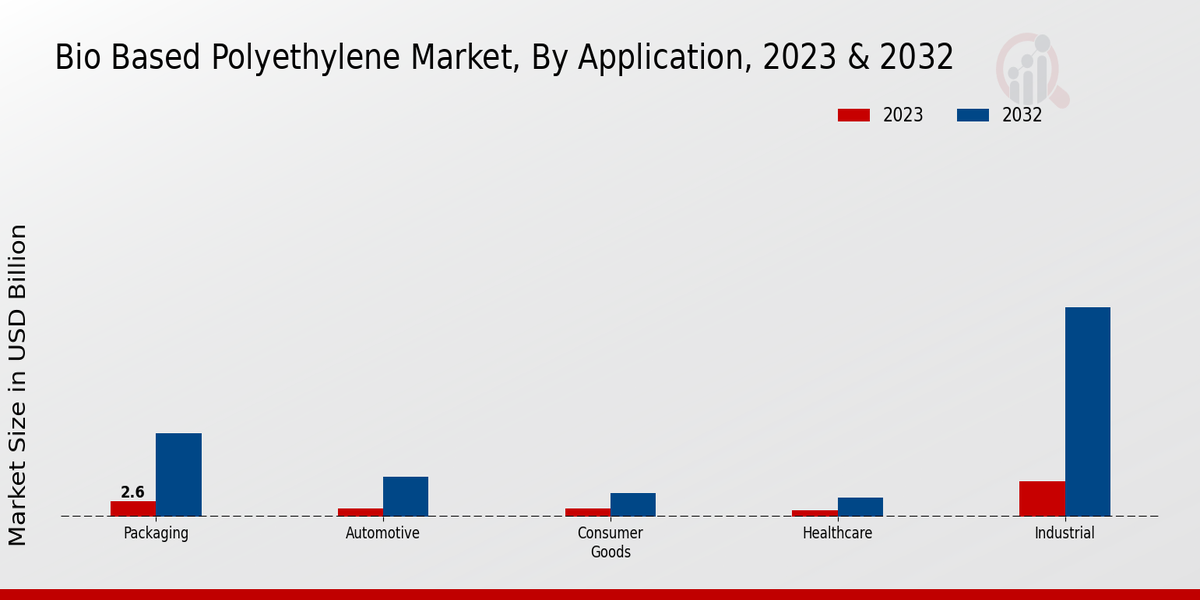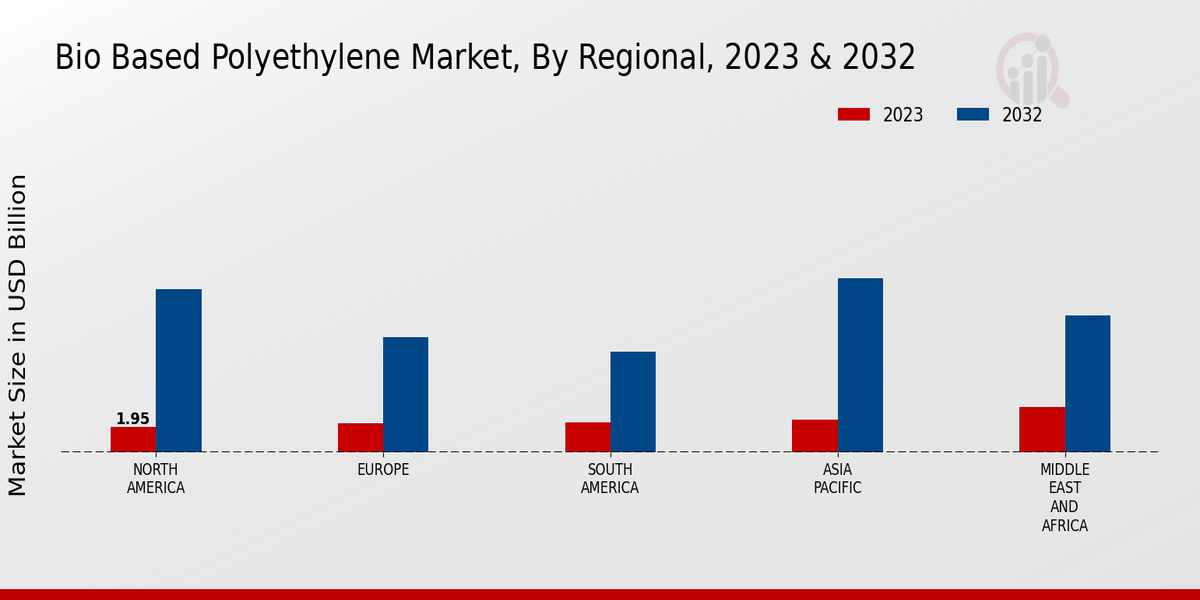Global Bio-Based Polyethylene Market Overview
The Bio-Based Polyethylene Market Size was estimated at 10.66(USD Billion) in 2024. The Bio-Based Polyethylene Industry is expected to grow from 13.1 (USD Billion) in 2025 to 83.49 (USD Billion) by 2034. The Bio-Based Polyethylene Market CAGR (growth rate) is expected to be around 22.85% during the forecast period (2025 - 2034).
Key Bio-Based Polyethylene Market Trends Highlighted
The bio-based polyethylene market is witnessing significant growth due to rising environmental concerns and the need for sustainable materials. The increasing demand for biodegradable and renewable plastics in various industries, such as packaging, consumer goods, and automotive, is driving market expansion. The growing awareness of the adverse effects of traditional plastics on the environment has spurred the adoption of bio-based alternatives.Recent market trends include advancements in bio-based polyethylene production technologies, leading to improved performance and cost-effectiveness. Additionally, collaborations between research institutions and industry players are accelerating innovation and the development of new applications. The increasing demand for bio-based polyethylene from emerging economies, where urbanization and population growth drive the need for sustainable solutions, presents significant growth opportunities.

Source: Primary Research, Secondary Research, MRFR Database and Analyst Review
Bio-Based Polyethylene Market Drivers
Growing Demand for Sustainable Packaging
The growing demand for sustainable packaging is a major driver of the Bio-Based Polyethylene Market Industry. Consumers are increasingly becoming aware of the environmental impact of traditional plastic packaging and are demanding more sustainable alternatives. Bio-based polyethylene is a renewable and biodegradable alternative to traditional plastics and is therefore well positioned to meet this growing demand. The packaging industry is one of the largest consumers of plastics and the shift towards sustainable packaging is expected to drive significant growth in the Bio-Based Polyethylene Market Industry.
Government Regulations and Policies
Government regulations and policies are another major driver of the Bio-Based Polyethylene Market Industry. Governments around the world are increasingly implementing regulations and policies that promote the use of sustainable materials, including bio-based plastics. For example, the European Union has set a target of recycling 55% of plastic packaging by 2032 and has also banned the use of certain single-use plastics. These regulations and policies are expected to create a favorable environment for the growth of the Bio-Based Polyethylene Market Industry.
Technological Advancements
Technological advancements are also driving the growth of the Bio-Based Polyethylene Market Industry. Advances in biotechnology and materials science have led to the development of new and improved bio-based polyethylene materials with better properties and performance. These advancements are making bio-based polyethylene more competitive with traditional plastics and are opening up new applications for bio-based polyethylene.
Bio-Based Polyethylene Market Segment Insights
Bio-Based Polyethylene Market Application Insights
The Bio Based Polyethylene Market is segmented into various applications, including packaging, automotive, consumer goods, healthcare and industrial. Packaging is the dominant application segment, accounting for over 50% of the Bio Based Polyethylene Market revenue in 2023. The increasing demand for sustainable packaging solutions is driving the growth of this segment. Bio-based polyethylene is gaining popularity as an eco-friendly alternative to traditional plastics in packaging applications due to its biodegradability and lower carbon footprint.The automotive industry is another significant application segment for Bio-Based Polyethylene. The rising adoption of lightweight materials in vehicle manufacturing and the growing demand for fuel-efficient vehicles are contributing to the growth of this segment. Bio-based polyethylene is used in various automotive components, such as interior parts, exterior panels and under-the-hood applications. Consumer goods is another promising application segment for Bio-Based Polyethylene. The growing awareness of environmental concerns and the increasing demand for sustainable products are driving the adoption of Bio-Based Polyethylene in consumer goods applications.It is used in various products, including toys, appliances, and housewares. The healthcare industry is also witnessing increasing adoption of Bio-Based Polyethylene. Its biocompatibility and low toxicity make it suitable for use in medical devices, implants and drug delivery systems. The growing demand for minimally invasive procedures and the increasing focus on patient safety are contributing to the growth of this segment. Industrial applications represent a significant growth opportunity for Bio-Based Polyethylene. It is used in various industrial applications, such as films, coatings and adhesives.The growing demand for durable and sustainable materials in industrial applications is driving the growth of this segment. Overall, the Bio Based Polyethylene Market is expected to experience robust growth in the coming years. The increasing demand for sustainable and eco-friendly materials, coupled with the growing adoption of Bio-Based Polyethylene in various applications, is expected to drive the market growth.

Source: Primary Research, Secondary Research, MRFR Database and Analyst Review
Bio-Based Polyethylene Market Raw Material Insights
The raw material segment plays a crucial role in the Bio-Based Polyethylene Market, with various plant-based materials being utilized for bio-based polyethylene production. Sugarcane, corn, cellulose, algae and other plant-based materials are the primary raw materials used in this market. The choice of raw material depends on factors such as availability, cost-effectiveness and environmental sustainability. The Bio Based Polyethylene Market from Sugarcane is projected to witness significant growth due to its high availability and cost-competitiveness.Corn is another major raw material, particularly in North America, owing to its well-established supply chain and government support for biofuel production. Cellulose, derived from wood pulp and other plant sources, offers advantages in terms of sustainability and biodegradability, contributing to the growing demand for bio-based polyethylene. Algae, though a relatively new raw material source, has gained attention due to its potential for high biomass yield and low land requirements. Other plant-based materials, such as straw, rice husks and bagasse, are also being explored for their potential in bio-based polyethylene production, contributing to the diversity of raw materials in this market.As a result, the raw material segment is expected to continue to evolve, driven by innovation and advancements in sustainable feedstock utilization.
Bio-Based Polyethylene Market Production Process Insights
The production process segment is a crucial aspect of the Bio-Based Polyethylene Market, with significant implications for market growth and industry dynamics. The market segmentation provides insights into the various production methods used to manufacture bio-based polyethylene, each with its unique advantages and challenges. Fermentation, dehydration, and polymerization are the primary production processes employed in the industry. Fermentation involves the use of microorganisms to convert biomass into bio-based monomers, which are then dehydrated to form bio-based polyethylene.This process is widely adopted due to its cost-effectiveness and scalability. Dehydration directly converts biomass into bio-based polyethylene through a chemical reaction, offering high yields and purity. Polymerization, on the other hand, involves the combination of bio-based monomers to form high-molecular-weight polyethylene. This process provides greater control over the properties of the final product but can be more complex and expensive. The choice of production process depends on factors such as feedstock availability, desired product quality and production scale.
Bio-Based Polyethylene Market Additive Type Insights
The Bio Based Polyethylene Market is segmented into additive types, which include bio-based fillers, bio-based plasticizers, bio-based antioxidants and bio-based UV stabilizers. In 2023, the bio-based fillers segment held the largest market share of 38.5%. The growth of this segment can be attributed to the increasing demand for lightweight and durable materials in various industries, including automotive, packaging and construction. Bio-based plasticizers are expected to witness significant growth over the forecast period due to their ability to improve the flexibility and processability of bio-based polyethylene.The bio-based antioxidants segment is projected to grow steadily, driven by the rising demand for bio-based materials with enhanced oxidative stability. The bio-based UV stabilizers segment is expected to experience moderate growth, owing to the increasing awareness of the harmful effects of UV radiation on bio-based materials. Overall, the Bio Based Polyethylene Market market for additive type is expected to reach a valuation of USD 2.5 billion by 2032, exhibiting a CAGR of 20.5% during the forecast period.
Bio-Based Polyethylene Market Property Insights
The properties of bio-based polyethylene (Bio-PE) play a crucial role in determining its market growth and segmentation. Bio-PE exhibits various properties that make it a viable alternative to conventional polyethylene. Biodegradability: Bio-PE is biodegradable, which means it can break down into natural elements over time. This property makes it an environmentally friendly choice for applications where sustainability is a concern. Composability: Some grades of Bio-PE are compostable, meaning they can be broken down by microorganisms in a controlled environment.This property enables Bio-PE to be disposed of in organic waste streams, reducing its environmental impact. Mechanical Strength: Bio-PE offers comparable mechanical strength to conventional polyethylene, making it suitable for a wide range of applications. Its tensile strength, impact resistance, and elongation at break meet the requirements of various industries. Thermal Resistance: Bio-PE exhibits good thermal resistance, allowing it to withstand high temperatures without significant degradation. This property makes it suitable for applications that involve heat exposure, such as automotive parts and packaging.Moisture Barrier: Bio-PE provides an effective moisture barrier, protecting products from moisture ingress. The increasing demand for sustainable and eco-friendly materials is driving the growth of the Bio-Based Polyethylene Market.
Bio-Based Polyethylene Market Regional Insights
The Bio Based Polyethylene Market is exhibiting promising growth prospects across various regions. North America holds a significant market share due to increasing demand from packaging and automotive industries. Europe follows closely, driven by stringent environmental regulations and growing consumer preference for sustainable products. The Asia-Pacific region is anticipated to witness substantial growth, attributed to rising disposable income and rapid urbanization. South America and MEA regions are expected to contribute to the overall market growth, owing to increasing awareness about bio-based materials and favorable government policies.The Bio Based Polyethylene Market revenue is projected to reach USD 45.0 billion by 2032, expanding at a CAGR of 22.85% from 2023 to 2032. This growth is attributed to factors such as government initiatives promoting bio-based plastics, rising demand for sustainable packaging solutions, and growing consumer consciousness towards environmental conservation.

Source: Primary Research, Secondary Research, MRFR Database and Analyst Review
Bio-Based Polyethylene Market Key Players And Competitive Insights
Major players in Bio Based Polyethylene Market industry are actively involved in expanding their product portfolios by investing in research and development activities to cater to the evolving demands of end-users. Strategic collaborations and partnerships with other players in the value chain are also becoming increasingly common, aiming to strengthen market positions and enhance competitiveness. Leading Bio-Based Polyethylene Market players are focusing on developing innovative and sustainable bio-based polyethylene solutions that meet the growing demand for eco-friendly packaging and automotive applications. The Bio Based Polyethylene Market development is expected to be driven by the increasing adoption of bioplastics across various industries, government regulations promoting sustainability, and rising consumer awareness regarding the environmental impact of traditional plastics. The Bio-Based Polyethylene Market Competitive Landscape is characterized by intense competition, with established players holding a significant market share. These players are continually innovating and expanding their product offerings to meet the evolving needs of customers.Braskem is a leading producer of bio-based plastics and a major player in the Bio-Based Polyethylene Market. The company offers a range of bio-based polyethylene products, including polyethylene terephthalate (PET) and polyethylene furanoate (PEF), which are derived from renewable feedstocks such as sugarcane. Braskem has a strong focus on sustainability and is committed to reducing its carbon footprint throughout its operations. The company has invested heavily in research and development to develop innovative bio-based polyethylene solutions that meet the needs of its customers. Braskem's commitment to sustainability and its extensive product portfolio has made it a leading player in the Bio-Based Polyethylene Market.Mitsubishi Chemical is a chemical company with a presence in the Bio-Based Polyethylene Market. The company offers a range of bio-based polyethylene products, including polyethylene made from renewable feedstocks such as sugarcane and wood. Mitsubishi Chemical has a strong focus on innovation and has developed advanced technologies for the production of bio-based polyethylene. The company's commitment to sustainability and its extensive product portfolio has made it a leading player in the Bio-Based Polyethylene Market.
Key Companies in the Bio-Based Polyethylene Market Include
- Toyobo
- Solvay
- Myriadt
- PTT Chemical
- Plantic Technologies
- Novamont
- Bio odw
- Danimer Scientific
- NatureWorks
- SK Chemicals
- Arkema Group
- Kaneka Corporation
- BioLogiQ
- Braskem
Bio-Based Polyethylene Market Industry Developments
Rising environmental concerns and increasing demand for sustainable packaging solutions are driving the market growth. Government initiatives and regulations promoting bio-based materials further contribute to market expansion.Recent developments include Borealis and Borouge's collaboration to establish a dedicated bio-based polyethylene production plant in Belgium, scheduled to commence operations in 2025. SABIC has also announced plans to invest in bio-based polyethylene production, leveraging its Trucircle portfolio to offer sustainable solutions. These investments indicate the growing industry focus on meeting the increasing demand for environmentally friendly plastics.
Bio-Based Polyethylene Market Segmentation Insights
Bio-Based Polyethylene Market Application Outlook
- Packaging
- Automotive
- Consumer Goods
- Healthcare
- Industrial
Bio-Based Polyethylene Market Raw Material Outlook
- Sugarcane
- Corn
- Cellulose
- Algae
- Other Plant-Based Materials
Bio-Based Polyethylene Market Production Process Outlook
- Fermentation
- Dehydration
- Polymerization
Bio-Based Polyethylene Market Additive Type Outlook
- Bio-based Fillers
- Bio-based Plasticizers
- Bio-based Antioxidants
- Bio-based UV Stabilizers
Bio-Based Polyethylene Market Property Outlook
- Biodegradability
- Composability
- Mechanical Strength
- Thermal Resistance
- Moisture Barrier
Bio-Based Polyethylene Market Regional Outlook
- North America
- Europe
- South America
- Asia Pacific
- Middle East and Africa
| Report Attribute/Metric |
Details |
| Market Size 2024 |
10.66(USD Billion) |
| Market Size 2025 |
13.1(USD Billion) |
| Market Size 2034 |
83.49(USD Billion) |
| Compound Annual Growth Rate (CAGR) |
22.90% (2025 - 2034) |
| Report Coverage |
Revenue Forecast, Competitive Landscape, Growth Factors, and Trends |
| Base Year |
2024 |
| Market Forecast Period |
2025 - 2034 |
| Historical Data |
2020 - 2024 |
| Market Forecast Units |
USD Billion |
| Key Companies Profiled |
Toyobo, Solvay, Myriadt, PTT Chemical, Plantic Technologies, Novamont, Bio odw, Danimer Scientific, NatureWorks, SK Chemicals, Arkema Group, Kaneka Corporation, BioLogiQ, Braskem |
| Segments Covered |
Application, Raw Material, Production Process, Additive Type, Property, Regional |
| Key Market Opportunities |
1. Expansion in end-use industries 2. Government initiatives for biobased products 3. Technological advancements 4. Growing environmental concerns 5. Rise in demand for sustainable packaging |
| Key Market Dynamics |
1. Increasing environmental concerns 2. government regulations 3. technological advancements 4. growing demand for sustainable packaging bioeconomy development |
| Countries Covered |
North America, Europe, APAC, South America, MEA |
Frequently Asked Questions (FAQ) :
The Bio Based Polyethylene Market was projected to reach USD 13.1billion in 2025.
The Bio Based Polyethylene Market is anticipated to grow at a CAGR of 22.90% from 2025 to 2034.
The Bio Based Polyethylene Market is projected to reach USD 83.49 billion by 2034.
Asia Pacific is expected to hold the largest market share in the Bio-Based Polyethylene Market in 2023.
The packaging segment is expected to hold the largest market share in the Bio-Based Polyethylene Market in 2025.
Braskem, Nature Works, Mitsubishi Chemical, and Toray Industries are some of the key competitors in the Bio-Based Polyethylene Market.
The growing demand for sustainable packaging and the increasing environmental concerns are major factors driving the growth of the Bio-Based Polyethylene Market.
The high cost of production and the limited availability of raw materials are major challenges faced by the Bio Based Polyethylene Market.
The increasing adoption of bioplastics and the development of new technologies are key trends expected to shape the future of the Bio-Based Polyethylene Market.
The Bio Based Polyethylene Market is expected to have a positive impact on the environment by reducing greenhouse gas emissions and promoting the use of renewable resources.

















